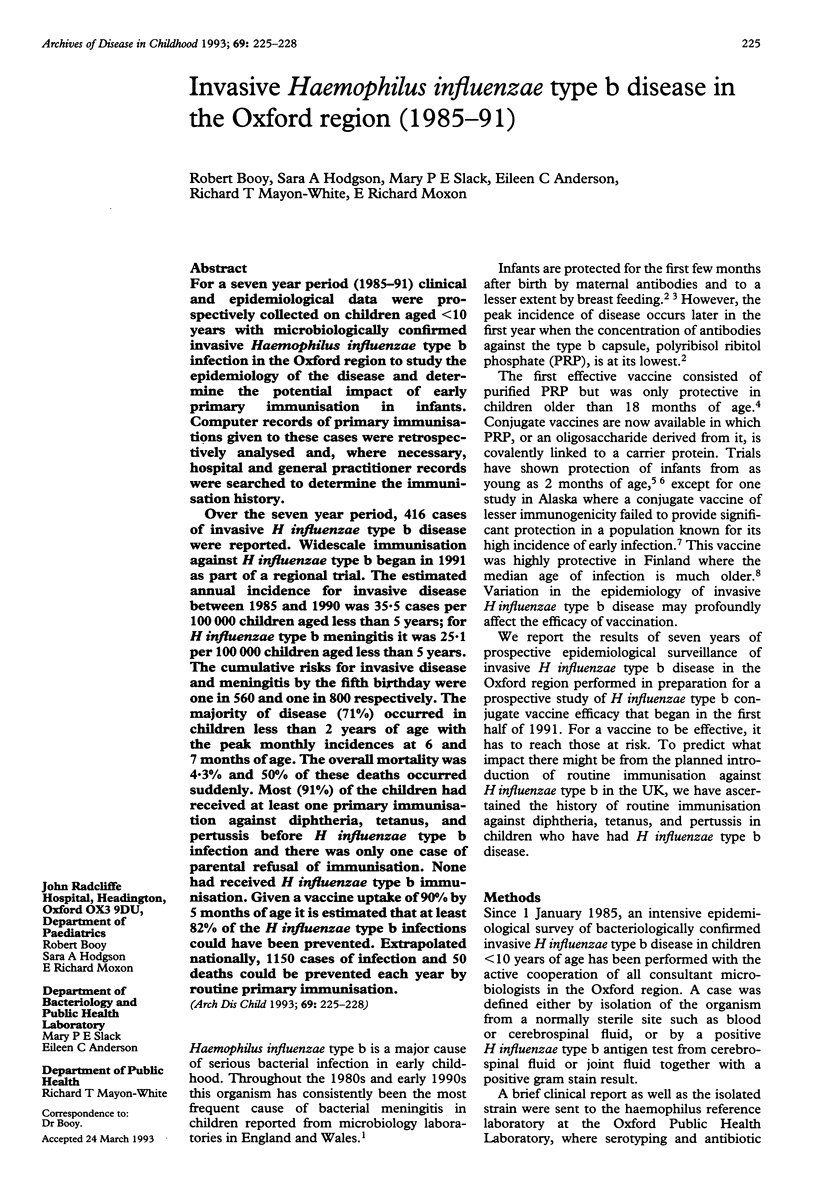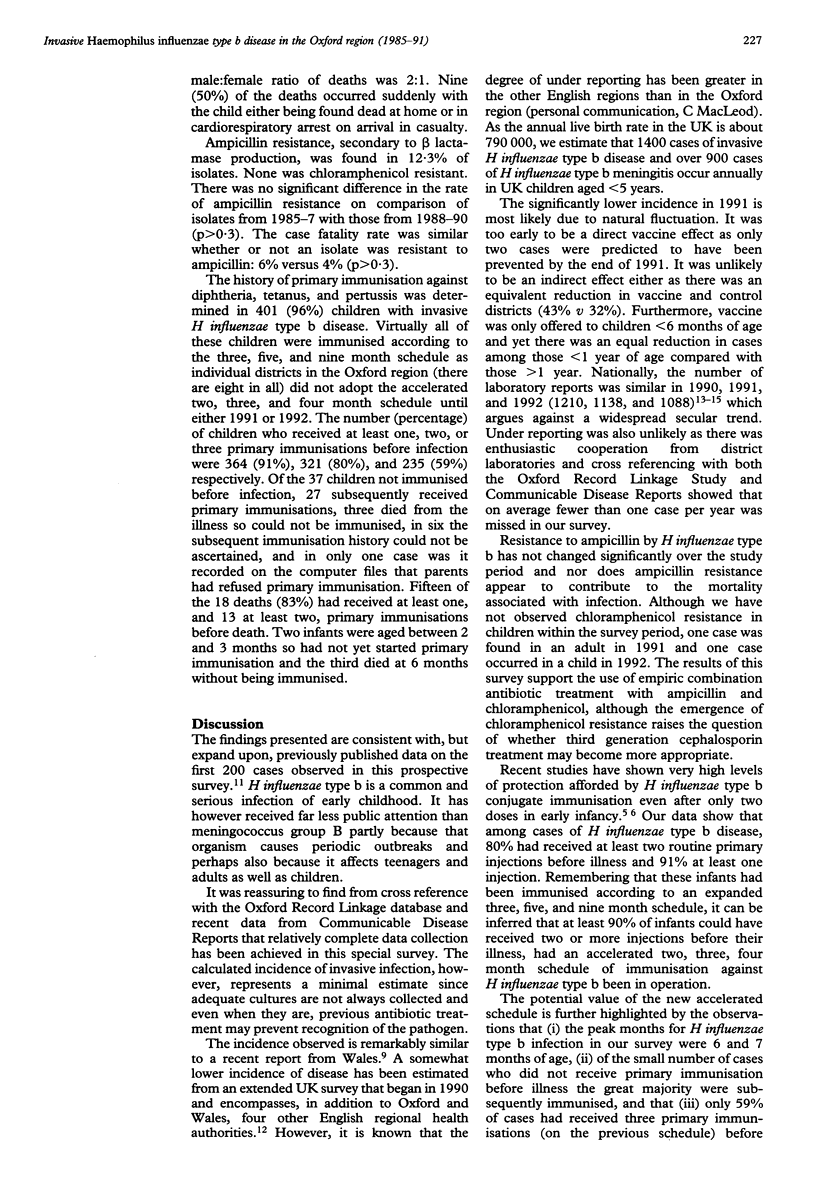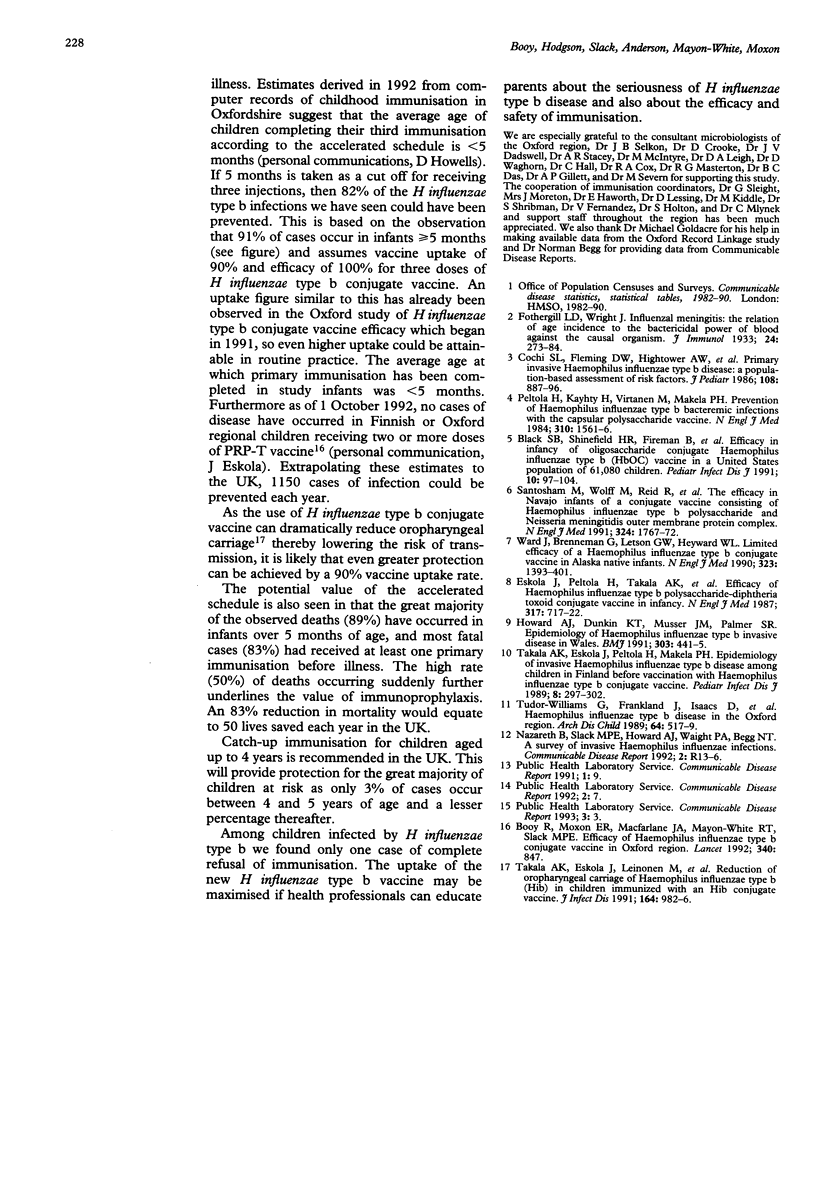Abstract
For a seven year period (1985-91) clinical and epidemiological data were prospectively collected on children aged < 10 years with microbiologically confirmed invasive Haemophilus influenzae type b infection in the Oxford region to study the epidemiology of the disease and determine the potential impact of early primary immunisation in infants. Computer records of primary immunisations given to these cases were retrospectively analysed and, where necessary, hospital and general practitioner records were searched to determine the immunisation history. Over the seven year period, 416 cases of invasive H influenzae type b disease were reported. Widescale immunisation against H influenzae type b began in 1991 as part of a regional trial. The estimated annual incidence for invasive disease between 1985 and 1990 was 35.5 cases per 100,000 children aged less than 5 years; for H influenzae type b meningitis it was 25.1 per 100,000 children aged less than 5 years. The cumulative risks for invasive disease and meningitis by the fifth birthday were one in 560 and one in 800 respectively. The majority of disease (71%) occurred in children less than 2 years of age with the peak monthly incidences at 6 and 7 months of age. The overall mortality was 4.3% and 50% of these deaths occurred suddenly. Most (91%) of the children had received at least one primary immunisation against diphtheria, tetanus, and pertussis before H influenzae type b infection and there was only one case of parental refusal of immunisation. None had received H influenzae type b immunisation. Given a vaccine uptake of 90% by 5 months of age it is estimated that at least 82% of the H influenzae type b infections could have been prevented. Extrapolated nationally, 1150 cases of infection and 50 deaths could be prevented each year by routine primary immunisation.
Full text
PDF



Selected References
These references are in PubMed. This may not be the complete list of references from this article.
- Black S. B., Shinefield H. R., Fireman B., Hiatt R., Polen M., Vittinghoff E. Efficacy in infancy of oligosaccharide conjugate Haemophilus influenzae type b (HbOC) vaccine in a United States population of 61,080 children. The Northern California Kaiser Permanente Vaccine Study Center Pediatrics Group. Pediatr Infect Dis J. 1991 Feb;10(2):97–104. doi: 10.1097/00006454-199102000-00004. [DOI] [PubMed] [Google Scholar]
- Booy R., Moxon E. R., MacFarlane J. A., Mayon-White R. T., Slack M. P. Efficacy of Haemophilus influenzae type B conjugate vaccine in Oxford region. Lancet. 1992 Oct 3;340(8823):847–847. doi: 10.1016/0140-6736(92)92719-v. [DOI] [PubMed] [Google Scholar]
- Cochi S. L., Fleming D. W., Hightower A. W., Limpakarnjanarat K., Facklam R. R., Smith J. D., Sikes R. K., Broome C. V. Primary invasive Haemophilus influenzae type b disease: a population-based assessment of risk factors. J Pediatr. 1986 Jun;108(6):887–896. doi: 10.1016/s0022-3476(86)80922-2. [DOI] [PubMed] [Google Scholar]
- Eskola J., Peltola H., Takala A. K., Käyhty H., Hakulinen M., Karanko V., Kela E., Rekola P., Rönnberg P. R., Samuelson J. S. Efficacy of Haemophilus influenzae type b polysaccharide-diphtheria toxoid conjugate vaccine in infancy. N Engl J Med. 1987 Sep 17;317(12):717–722. doi: 10.1056/NEJM198709173171201. [DOI] [PubMed] [Google Scholar]
- Howard A. J., Dunkin K. T., Musser J. M., Palmer S. R. Epidemiology of Haemophilus influenzae type b invasive disease in Wales. BMJ. 1991 Aug 24;303(6800):441–445. doi: 10.1136/bmj.303.6800.441. [DOI] [PMC free article] [PubMed] [Google Scholar]
- Peltola H., Käyhty H., Virtanen M., Mäkelä P. H. Prevention of Hemophilus influenzae type b bacteremic infections with the capsular polysaccharide vaccine. N Engl J Med. 1984 Jun 14;310(24):1561–1566. doi: 10.1056/NEJM198406143102404. [DOI] [PubMed] [Google Scholar]
- Santosham M., Wolff M., Reid R., Hohenboken M., Bateman M., Goepp J., Cortese M., Sack D., Hill J., Newcomer W. The efficacy in Navajo infants of a conjugate vaccine consisting of Haemophilus influenzae type b polysaccharide and Neisseria meningitidis outer-membrane protein complex. N Engl J Med. 1991 Jun 20;324(25):1767–1772. doi: 10.1056/NEJM199106203242503. [DOI] [PubMed] [Google Scholar]
- Takala A. K., Eskola J., Leinonen M., Käyhty H., Nissinen A., Pekkanen E., Mäkelä P. H. Reduction of oropharyngeal carriage of Haemophilus influenzae type b (Hib) in children immunized with an Hib conjugate vaccine. J Infect Dis. 1991 Nov;164(5):982–986. doi: 10.1093/infdis/164.5.982. [DOI] [PubMed] [Google Scholar]
- Takala A. K., Eskola J., Peltola H., Mäkelä P. H. Epidemiology of invasive Haemophilus influenzae type b disease among children in Finland before vaccination with Haemophilus influenzae type b conjugate vaccine. Pediatr Infect Dis J. 1989 May;8(5):297–302. [PubMed] [Google Scholar]
- Tudor-Williams G., Frankland J., Isaacs D., Mayon-White R. T., MacFarlane J. A., Slack M. P., Anderson E., Rees D. G., Moxon E. R. Haemophilus influenzae type b disease in the Oxford region. Arch Dis Child. 1989 Apr;64(4):517–519. doi: 10.1136/adc.64.4.517. [DOI] [PMC free article] [PubMed] [Google Scholar]
- Ward J., Brenneman G., Letson G. W., Heyward W. L. Limited efficacy of a Haemophilus influenzae type b conjugate vaccine in Alaska Native infants. The Alaska H. influenzae Vaccine Study Group. N Engl J Med. 1990 Nov 15;323(20):1393–1401. doi: 10.1056/NEJM199011153232006. [DOI] [PubMed] [Google Scholar]


